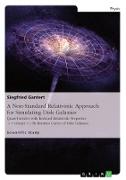A Non-Standard Relativistic Approach for Simulating Disk Galaxies
BücherAngebote / Angebote:
Scientific Study from the year 2020 in the subject Physics - Astronomy, grade: -, , language: English, abstract: In the present work, the gravitational discrepancies observed in disk galaxies are explained using a new relativistic theory beyond the standard model of physics. It assumes the existence of bosonic quasi-particles of a scalar field, which reach different relativistic velocities v < v(max) < c depending on her effective mass.
The magnitude of the limit velocity v(max) is derived from a hypothetical non-singularity condition of a quasi-particle at the velocity limit. Remarkably, it turns out that a good fit of the rotation curves is usually achieved by a relativistic velocity distribution of a galaxy-specific quasi-particle, where the maximum rotational velocity at the edge of a disk galaxy is approximately equal to the limit velocity v(max). From the relativistic velocity distribution a galaxy-specific halo with limited mass and finite size can be derived. The way dark matter can be characterized with the new approach suggests that entanglement and quantum correlation of quasi-particles plays a crucial role in the formation of a dark matter halo. To verify the model, 12 representative galaxies were selected from the SPARC data set [astroweb.cwru.edu/SPARC/] and evaluated according to the new relativistic model using the least squares regression method. A comparison of the obtained data with the empirical law of the radial acceleration relation shows high agreement. The SBM theory, which is based on a modification of special relativity theory, is applied here as a first-order approximation for bosonic quasi-particles in the asymptotic flat space of disk galaxies.
Folgt in ca. 10 Arbeitstagen
